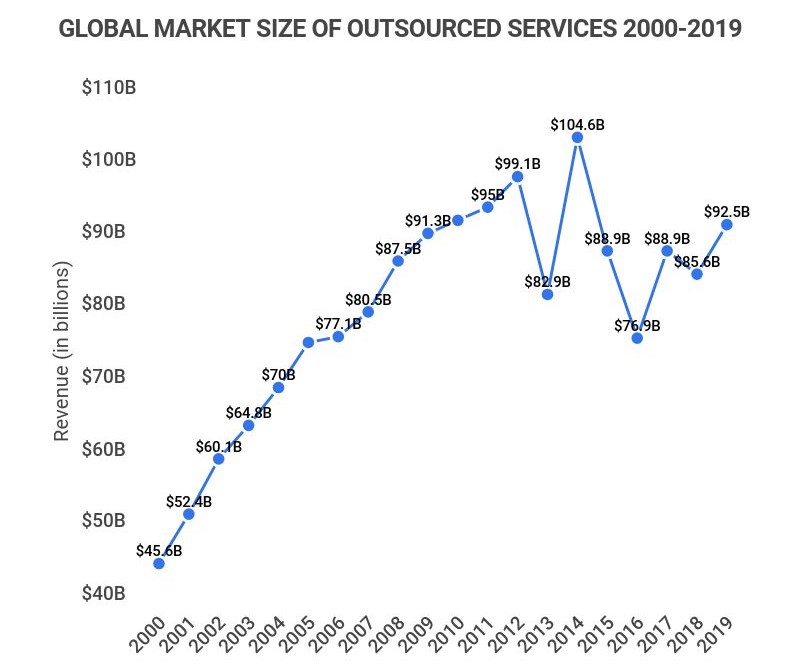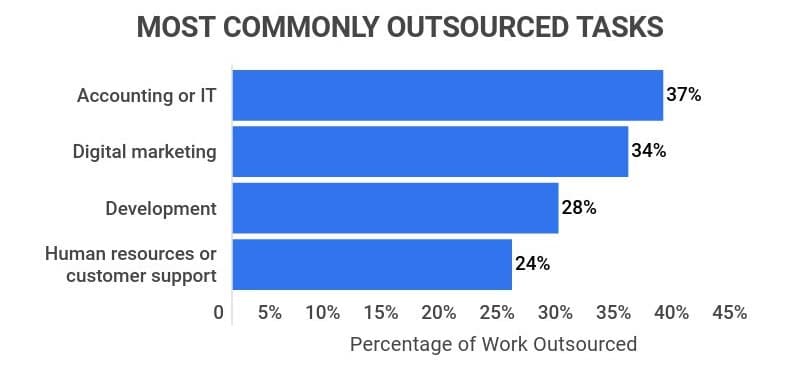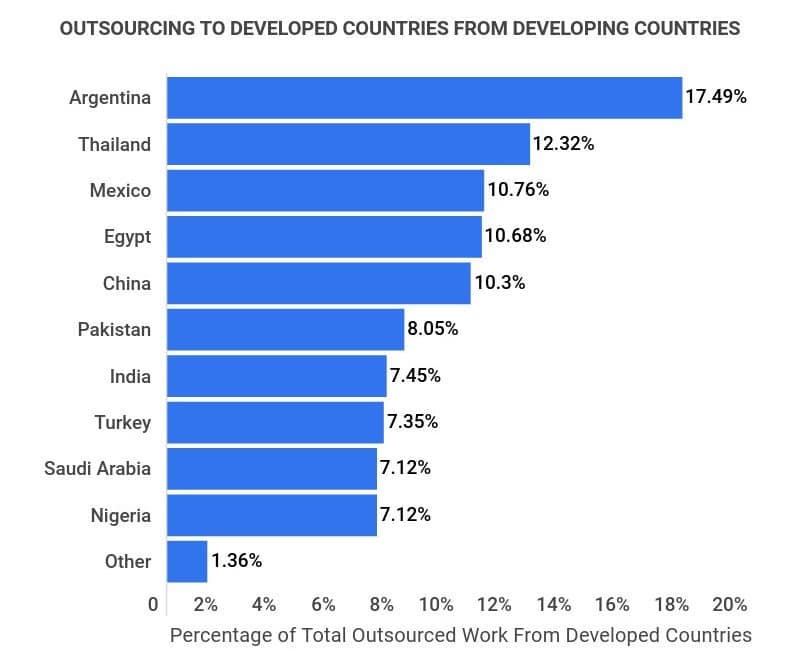One of the Reasons Small Businesses Continue to Thrive in the United States is Outsourcing
Research Summary. With more and more businesses across the U.S. looking for ways to increase profit margins and cut costs, outsourcing has become a popular business tool for both big and small companies across the nation.
To find out more, our data analysis team gathered an extensive list of United States outsourcing statistics. According to our extensive research:
-
Roughly 300,000 U.S. jobs are outsourced each year.
-
The global outsourcing market is valued at $92.5 billion, with the U.S. market bringing in $62 billion of the total international revenue.
-
66% of businesses in the United States outsource at least one department.
-
59% of businesses cite cost as the biggest reason for outsourcing.
-
Information technology is the leading industry and business department for outsourcing — 13.6% of the average IT department budget dedicated to outsourced tasks and about 37% of IT tasks are outsourced.
-
Globally, 78% of businesses that outsource work across the globe have a positive attitude towards their outsourcing partners.
-
The outsourcing market is expected to grow at a compound annual growth rate of 4% between 2021 and 2025.
-
Nearly a quarter (24%) of small businesses outsource to increase efficiency.
For further analysis, we broke down the data in the following ways:
Jobs Lost to Outsourcing | Company Size | Common Reasons | Trends | The Economy | Benefits + Issues

General Outsourcing Statistics
-
68% of large consumer products companies in the United States outsource a portion of their workforce.
More than two-thirds of big companies in the United States use outsourcing to some degree. Primary reasons for outsourcing included tight budgets and rising energy costs.
-
Companies across the nation hired more than 2 million outsourced workers in the 2000s.
Outsourcing exploded in the 2000s. During that time, U.S. companies cut their American workforces by roughly 2.9 million and used outsourcing to hire 2.4 million workers overseas, according to the CAP.
-
The global outsourcing service market is valued at more than $90 billion.
The international outsourcing market is valued at $92.5 billion as of 2019, with $62 billion generated through companies in the United States.
-
Most global outsourcing revenue is generated through the information technology sector.
In 2019, $66.5 billion was generated by information technology outsourcing, and $26 billion was generated by business process outsourcing.
-
Large multinational companies are the biggest proponents of outsourcing, especially overseas.
35% of large multinational companies headquartered in the United States added jobs faster than smaller companies in the country between 2010 and 2012, according to the WSJ. However, roughly three-fourths of the added jobs were outsourced overseas.
-
China is the top country the United States outsources to.
The U.S. outsources to China more than any other country. In addition, China's outsourcing market grows by 30% every year. Behind China, The Philippines, Taiwan, Ukraine, and Vietnam are among the top 5 countries U.S. businesses outsource to.

Outsourcing Statistics by Jobs Lost to Outsoucing
-
Roughly 30 million jobs are vulnerable to outsourcing.
More than one-fifth of jobs in the United States have the potential to be lost to outsourcing, according to a Princeston study.
-
Technology outsourcing represents the biggest outsourcing market in the world.
International technology outsourcing generated a whopping $66.5 billion in 2019. For comparison, business process outsourcing generated $26 billion.
-
Information technology departments are the most typically outsourced department in the United States.
It's estimated that 92% of organizations in North America engaged in information technology outsourcing, to some extent, in 2019.
-
High-paying industries that require advanced education and a refined skill set are among the top 10 industries that get outsourced overseas.
Computer programmers, data entry keyers, electrical and electronics drafters, mechanical drafters, and computer and information personnel are the top five occupations most vulnerable to outsourcing. Annual wages for the occupations lie between $26,350 and $100,640.
The report also listed actuaries, mathematicians, statisticians, mathematical science occupations, and film and video editors among the top ten U.S. careers most likely to get outsourced overseas.
Outsourcing Statistics by Company Size
-
80% of small businesses plan to outsource at least some of their work in 2022.
8 in 10 small businesses in the United States plan to outsource work this year to save their organization time and money.
-
Large businesses are 128% more likely to outsource work than small businesses.
29% of businesses with 50 or fewer employees outsource work compared to 66% of businesses with more than 50 employees.
-
More than half of America's large businesses outsource.
Data illustrates that 68% of large consumer products companies in the United States use outsourcing.
-
Accounting and information technology are the most commonly outsourced departments among small businesses.
Among small businesses that outsource, 37% outsource either accounting or IT services work, 34% outsource digital marketing work, 28% outsource development work, and 24% outsource either human resources work or customer support work.

-
71% of financial service executives outsource one or more services.
While the cost of financial functions only makes up a small percentage of most companies' overall budgets, it's often seen as a straightforward option for outsourcing.
Outsourcing Statistics by Most Common Reasons
-
59% of businesses outsource to cut costs.
More than half of all global companies that rely on outsourcing do so to save money. A global survey revealed that the majority of respondents said their company uses outsourcing as a cost-cutting tool.
-
26% of small businesses outsource to get help from an expert.
More than one-quarter of small businesses with ten or fewer employees outsource to experts to get business advice or help to complete specialized tasks.
For comparison, 17% of businesses with 11 to 50 employees, 14% of businesses with 51 to 250 employees, and 16% of businesses with 251 to 500 employees outsource to get help from an expert.
-
Outsourcing can cut labor costs by up to 90%.
Overseas outsourcing can help U.S. companies save 70% to 90% in labor costs. The biggest savings are seen when work is outsourced to countries with a low cost of living, like the Philippines.

Outsourcing Statistics Trends and Projections
-
The international outsourcing market has grown by $15.6 billion since 2016.
Based on data compiled in 2019, the global outsourcing market is currently valued at $92.5 billion. While revenue from outsourcing has been up and down for the past few years, the market was worth an estimated $76.9 billion in 2016. As such, the industry grew by $15.6 billion between 2016 and 2019.
-
The overall outsourcing market is expected to grow at a compound annual growth rate of 4% between 2012 and 2025.
Experts predict the overall international outsourcing market to increase at a CAGR of 4% over the next four years. At that rate, the market is on track to grow by $40.16 billion by 2025.
-
8 million American manufacturing jobs were outsourced between 1979-2009.
While outsourcing grows, some industries are suffering in the U.S. Outsourcing has taken a toll on the American manufacturing industry in particular. The manufacturing market lost 8 million American workers between 1979 and 2009, with roughly 19.5 million jobs in June 1979 and only 11.5 million in December 2009.
Additionally, manufacturing plants have declined by 12.5% between 1998 and 2008, with 51,000 plants closing their doors across the country.
-
Despite increasing costs, few American companies (4%) plan to relocate outsourced jobs back to the United States.
While the cost gap between the United States and China is decreasing (meaning that outsourcing costs are increasing), few companies plan on bringing jobs back to the U.S. Only 4% of large American companies plan to bring outsourced jobs back to the United States according to a Duke's School of Business survey.
-
70% of surveyed companies plan to outsource more work in the near future.
The large majority of companies plan to outsource more in the future. Moreover, 35% plan to significantly increase the number of jobs they outsource.
-
38% of the predicted global outsourcing market growth will happen in the United States.
More than one-third of outsourcing market growth will be tied to the United States. Information technology and telecommunication outsourcing are expected to lead market growth.
-
The number of U.S.-based freelancers grew by 22% between 2019 and 2020.
The number of working freelancers in the United States is growing rapidly, primarily fueled by younger professionals seeking flexible work opportunities. The American freelance workforce contributed $1.2 trillion to the U.S. economy between 2019 and 2021.
Outsourcing Statistics and the Economy
-
In terms of value, 84.2% of outsourcing deals originate in the U.S.
Most outsourcing deals originate in the United States, when we look at the actual value of the work being done. The second most valuable generator of outsourcing is the United Kingdom, generating 5.2% of global outsourcing deals.
-
42% of global outsourcing deals come from North America and South America.
The United States is the leader of outsourcing in the Americas, and, according to a global report from KPMG, 42% of international outsourcing is tied to North America and South America.
For comparison, the report estimates that 35% of outsourcing comes from Europe, the Middle East, and Africa, and 23% of outsourcing comes from Asia and Oceania.
-
Computer and mathematical occupations are the top jobs being outsourced in the U.S.
According to labor statistics, computer and mathematical occupations in the U.S. are almost equal to the amount of computer and mathematical occupations offshored from the U.S.
The U.S. Bureau of Labor Statistics reports that other top jobs are being outsourced, including business and financial operations occupations, architecture and engineering occupations, legal occupations and sales, and other related occupations.
Outsourcing Statistics by Benefits and Issues
-
Most business executives are satisfied with outsourcing because of financial benefits.
Roughly 59% of businesses are happy with outsourcing work because it saves money and is an effective cost-cutting tool.
-
Roughly one-third of working professionals resist outsourcing.
Research shows that about 33% of professionals do not support outsourcing due to fear of losing their job. In addition, employees working for companies that outsource report a 66% increase in job insecurity.
-
Outsourcing from other countries creates more work in the United States.
While the U.S. largely outsources its work to developing countries to cut back on costs, more and more developing countries have been outsourcing work to the United States and other developing economies as a means of gaining access to top global markets.
17.49% of work outsourced to developed economies comes from Argentina. Behind Argentina, Thailand, Mexico, Egypt, China, Pakistan, India, Turkey, Saudi Arabia, and Nigeria are the biggest outsourcers to the U.S. and other developed nations.

Outsourcing FAQ
-
What is outsourcing?
Outsourcing is the process of relocating a company's internal duties to an external party. There are two types of outsourcing: business process outsourcing, or BPO, and information technology outsourcing, or ITO.
Business process outsourcing relocates business operations to a service provider or company outside the organization. Information technology outsourcing refers to outsourcing a company's IT needs and responsibilities.
Outsourcing is very often associated with offshoring, the process of relocating a company's jobs overseas. Companies most often outsource jobs offshore in an effort to save money and resources. In 2019, India was considered the best country for offshoring.
-
What is the success rate of outsourcing?
Approximently three-quarters of outsourcing operations are successful. More specifically, 78% of businesses that outsource report a positive attitude toward their outsourcing partners, which indicates success.
-
What percentage of U.S. companies outsource?
66% of U.S. companies with 50 or more employees outsource, while 29% of U.S. companies with fewer than 50 employees outsource. Furthermore, 68% of large U.S. consumer products involve outsourcing in at least one department of their organization.
-
What percentage of American jobs are outsourced?
Roughly 4.5% American jobs are outsourced each year. While the U.S. added a record 6.4 million new jobs at home in 2021, it also outsourced about 300,000 jobs to other countries. So of the 6.7 million total jobs America created in 2021, approximately 95.5% of them went to Americans and 4.5% were outsourced.
-
What countries outsource the most?
The United States and the United Kingdom outsource the most. While 68% of large consumer product companies in the U.S. outsource, about 48% of U.K. companies do the same. By the value of outsourcing deals, the gap is even wider — the U.S. accounts for 84.2% of outsourcing deals compared to the U.K. at 5.2%.
Conclusion
For businesses across the United States and worldwide, outsourcing is a tool for cutting costs, increasing efficiency, and completing specialized tasks. With roughly 66% of American companies outsourcing jobs, the country generates an impressive $62 billion of the outsourcing market's $92.5 billion global value.
Although outsourcing often equates to losing American jobs, it also significantly helps U.S. businesses. Today, it's estimated that approximately 300,000 U.S. jobs are outsourced every year, with more than one-fifth of occupations having the potential to be outsourced in the future.
Current data shows that the outsourcing market will continue on an upwards trajectory. Growing at a compound annual growth rate of 4% between now and 2025, the international industry is expected to grow by $40.16 billion by 2025.
References
-
Population Reference Bureau. "Offshoring U.S. Labor Increasing." Accessed on September 26, 2021.
-
Statista. "Global Outsourcing Market Size 2000-2019." Accessed on September 27, 2021.
-
Statista. "Outsourcing Penetration Rate In North America By Country 2019." Accessed on September 27, 2021.
-
PR Newswire. "Business Process Outsourcing Market To Grow By USD 40.16 Billion During 2021-2025." Accessed on September 27, 2021.
-
Reliable Plant. "68% of U.S. Consumer Products Companies Use Outsourcing." Accessed on September 30, 2021.
-
Center for American Progress. "5 Facts About Overseas Outsourcing." Accessed on September 30, 2021.
-
Statista. "Global Outsourcing Industry Revenue From 2010 to 2019, By Service Type." Accessed on September 30, 2021.
-
Business Insider. "The 5 Best Countries To Outsource To In 2019—Plus, The Top 14 Outsourcing Companies Data Entry Agencies." Accessed on September 30, 2021.
-
Outsource Accelerator. "How Outsourcing Can Cut Labor Costs By Up To 70%." Accessed on September 30, 2021.
-
PR Newswire. "80% Of Small Businesses Plan To Outsource In 2021, Citing The Ability To Save Time, Grow Their Business And Work With Experts." Accessed on September 30, 2021.
-
CNBC. "A Snapshot Of The $1.2 Trillion Freelance Economy In The U.S. In The Age Of COVID-19." Accessed on September 30, 2021.
-
Devabit. "The Future Of IT Outsourcing." Accessed on September 30, 2021.
-
Clutch. "Small Business Outsourcing Statistics In 2019." Accessed on September 30, 2021.
-
Walden University. "Role Of Outsourcing In Stress And Job Satisfaction Of Information Technology Professionals." Accessed on September 30, 2021.
-
Invisible Technologies. "Important Outsourcing Trends And Statistics You Need To Know In 2020 (And Beyond)." Accessed on September 30, 2021.
-
CNBC. "The New Outsourcing Hot Spots: More Developing Nation Firms Tap Workers In U.S., Canada, Europe." Accessed on September 30, 2021.
-
U.S. Bureau of Labor Statistics. "Service-Providing Occupations, Offshoring, And The Labor Market." Accessed on September 30, 2021.
-
KPMG. "Global IT-BPO Outsourcing Deals Analysis." Accessed on September 30, 2021.
-
- Cloud Adoption Statistics
- Customer Loyalty Statistics
- Nonprofit Statistics
- Affiliate Marketing Statistics
- Cart Abandonment Rate Statistics
- Ridesharing Statistics
- Call Center Statistics
- eLearning statistics
- Customer Service Statistics
- Customer Experience statistics
- Entrepreneur Statistics
- Outsourcing Statistics
- Gross Revenue for Marketing and Advertising
- Sales Statistics
blancharduntrove56.blogspot.com
Source: https://www.zippia.com/advice/outsourcing-statistics/
0 Response to "One of the Reasons Small Businesses Continue to Thrive in the United States is Outsourcing"
Post a Comment